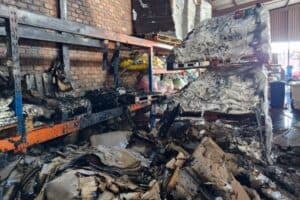To quote the Ekurhuleni head of department for electricity: “There’s an outage every minute.” This was evidenced in Boksburg these past 10 days.

Gauteng cities have become the concrete jungle – and its law is survival of the most prepared.
Because never mind load shedding, ageing infrastructure and poor maintenance sees disintegration of power grids and water networks faster than council teams can keep up …this is daily.
ALSO READ: Boksburg community threatens to boycott rates
To quote the Ekurhuleni head of department for electricity: “There’s an outage every minute.”
This was evidenced over the past 10 days with a sustained outage in much of Boksburg.
No power, no water
Meanwhile, some Johannesburg restaurants said they have not had water for almost a year and rely on tankers and JoJo tanks to wash the dishes.
Some Randburg residents went without water, then electricity, for days on end. It’s happening all over and not everyone can sink a borehole or install solar power at high cost.
But there are some preps that residents can make to soften the blow of prolonged electricity outages. And they will become more common, said several councillors across Johannesburg and Ekurhuleni.
“It’s like Doomsday preparations,” said ward councillor Simon Lapping, whose Kempton Park and Boksburg residents have collectively spent a fortnight without power.
Make sure you have an inverter. Though these only carry power for around four hours, it goes a long way to sparing mental health challenges, replacing a sustained generator hum with some silence.
It will also power your internet, television and charge your phones and keep your alarm powered throughout the night.
ALSO READ: #TotalShutdown: Limpopo residents stranded with no taxis in sight
A decent inverter that can do all of this will set you back between R15 000 to R20 000.
Power banks for phones and devices are an additional failsafe. Buy at least three of these, at an average of R1 000 each, to ensure that your alarm goes off in the morning.
Power banks and inverters will handle the dayto-day load shedding woes that every South African must endure.
A generator has become an absolute necessity for Average Joe because we live in not-so-average times.
When cable faults, blown up substations or burnt out whatever occur, repair times now vary from eight hours to days on end.
And no inverter or power bank can handle that. Invest in a decent generator because the dividends will pay off.
Purchase at least a 7-8KVA machine that will be able to, in turn, keep your fridges going for a few hours at a time, warm your geyser, recharge inverters, power banks and devices as well as allowing your microwave and air fryer to make something other than bread to eat.
But it doesn’t come cheap
A generator like this will set you back between R15 000 to R22 000. Fuel for an average household, to maintain a semblance of urban survival, will cost you around 10l a day.
That’s just over R500 with the new petrol price increase’s impact. Two days, budget a grand.
Emergency camp lights from outdoor stores are useful, as too are the rechargeable light bulbs from hardware stores; though the latter are not always as effective as limited lifespans make it somewhat pricey, but worth it.
An average home would need perhaps seven of them at R100 each, plus an investment of around R500 for batteries and emergency camping lights.
ALSO READ: We are the government’s blessers
To cook, camping stoves are cost-effective. They are available at most grocery stores with a camping and outdoor department for around R300 each.
Gas refills retail at R40 and lasts quite long. For a two-day outage, two gas bottles, a stove top kettle and a cooker will hover around the R1 000 mark.
Add to that a 2kg blue Cadac gas bottle and a skottel for variation and emergencies, so it’s about another R1 500.
So, being prepared for what’s likely coming has a hefty price tag.
Without fuel but including all the necessary cables and sundry items demands at least R40 000, plus a slush fund for petrol and, if you are worried about water, some cash for five containers of drinkable water.
Surviving the lack of service delivery is becoming unaffordable. It feels, indeed, like doomsday prepping.






